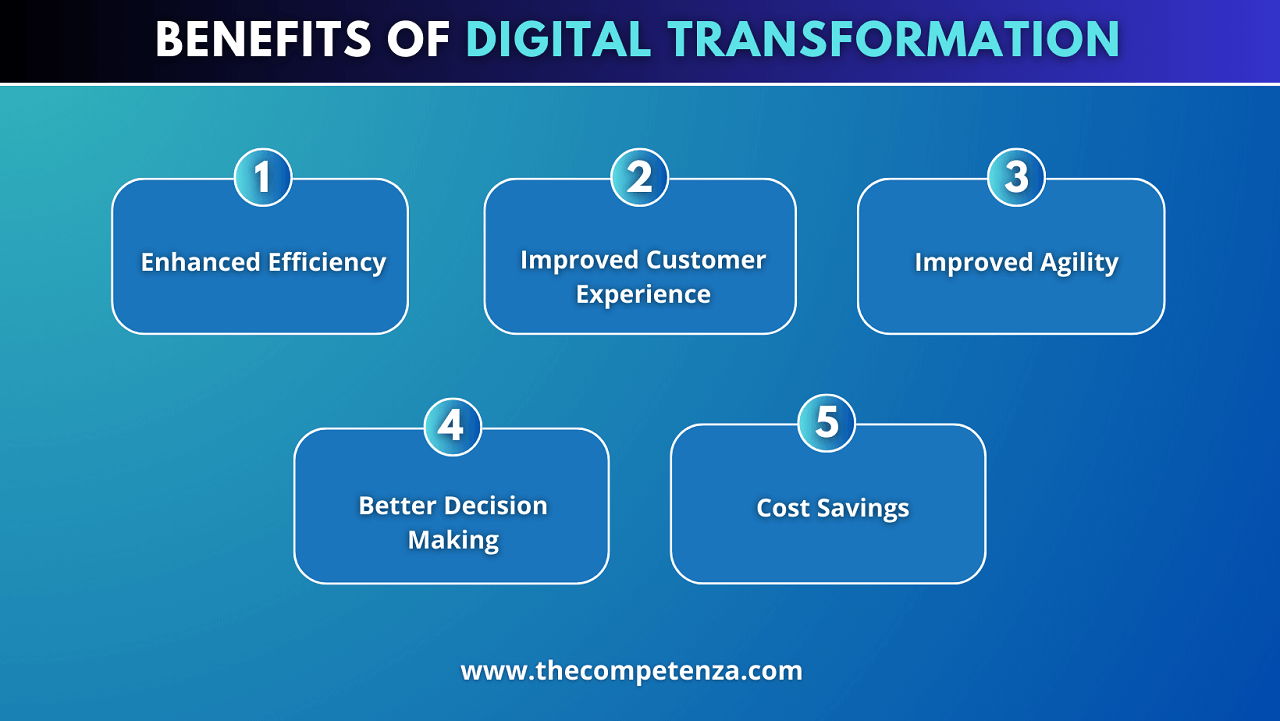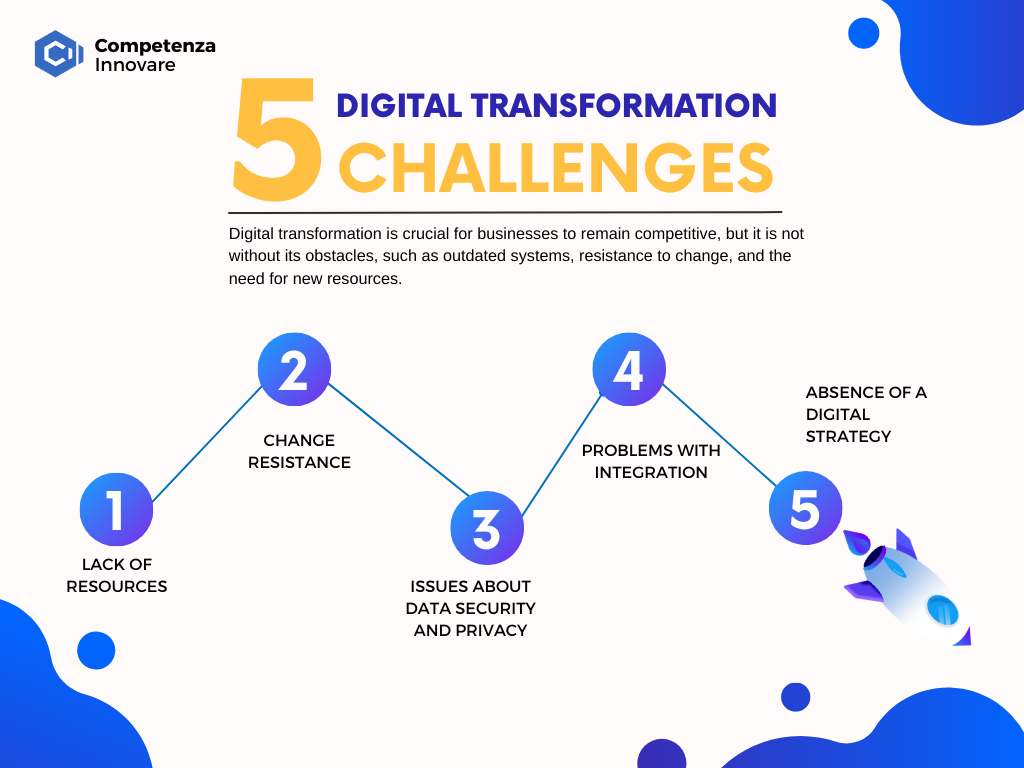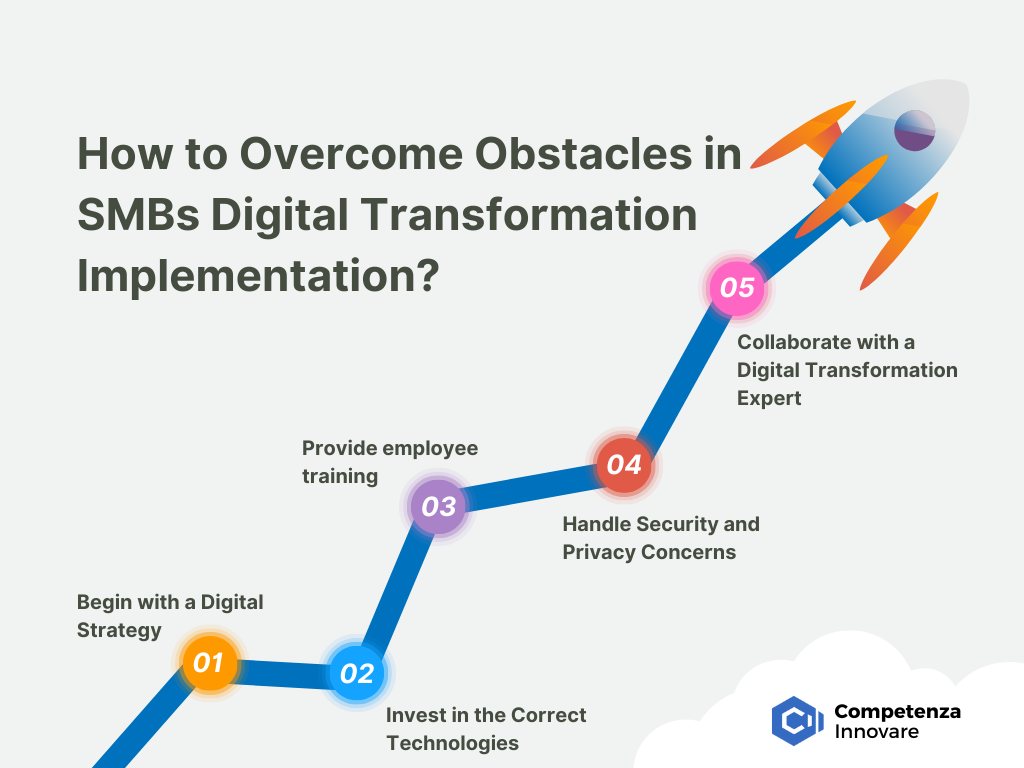Businesses are increasingly relying on digital technology for day-to-day operations in the modern day. The capacity to gather, store, and analyze massive volumes of data has become an essential component in decision-making processes. The use of technology to modify business models has become a big trend, and small and medium-sized businesses (SMBs) are no exception. SMEs are increasingly turning to digital transformation to stay competitive, earn consumer trust, and grow revenue.
In this blog article, we will look at what digital transformation is, how small businesses may adopt it, the benefits of digital transformation for small businesses, and the problems of executing it. We will also talk about how Competenza Innovare can assist small and medium-sized businesses (SMBs) with their digital transformation trends.
Let’s Understand Digital Transformation!
The integration of digital technology into all elements of a business, radically changing how organizations function and give value to consumers, is referred to as digital transformation. It entails a transition from manual to digital operations that are automated, simplified, and data-driven. Every area of a business is affected by digital transformation, from customer interactions to internal operations and supply chain management.
It entails employing technology to increase the efficiency, effectiveness, and agility of business operations, allowing organizations to remain competitive and satisfy changing client requirements.
How To Drive Digital Transformation for SMBs?

Digital transformation is a multifaceted and complicated process that needs careful strategy and implementation. These are some critical actions that SMBs may take to effectively achieve digital transformation:
#1. Identify Goals
Before beginning a digital transformation journey, SMEs must first determine their company goals and objectives. This entails identifying areas of the business that need to be improved, specifying desired results, and developing metrics to quantify progress.
#2. Evaluate Existing Capabilities
Small and medium-sized businesses (SMBs) must examine their present technological capabilities and infrastructure to identify gaps that must be filled. This includes examining the workforce’s skills and expertise as well as current hardware, software, and systems.
#3. Create a Strategy
SMBs must create a digital transformation plan outlining the measures they will take to attain their objectives. This includes assessing which technologies and solutions will be required, as well as how to integrate them into current systems and processes.
#4. Solutions Must Be Implemented
SMBs must implement the technologies and solutions outlined in the plan, ensuring that they are successfully integrated into existing systems and processes. This entails giving staff training and assistance to ensure that they are comfortable utilizing new technologies.
#5. Monitor and Evaluate
Small and medium-sized businesses (SMBs) must constantly monitor and analyze the efficacy of their digital transformation activities. This includes assessing success against set metrics, finding areas for improvement, and adjusting the approach as needed.
Advantages of Digital Transformation for Small Medium Businesses
SMEs may profit from digital transformation in a variety of ways, including:

1. Enhanced Efficiency
Digital transformation streamlines processes and automates repetitive operations, increasing operational efficiency and decreasing the need for manual intervention.
2. Improved Customer Experience
Through digital transformation, SMBs may deliver a more seamless and personalized customer experience, increasing customer happiness and loyalty.
3. Improved Agility
As a result of digital transformation, SMBs can adjust swiftly to changing market conditions and consumer expectations, allowing them to remain competitive.
4. Better Decision Making
Because digital transformation gives SMBs access to real-time data, they can make educated decisions based on correct insights.
5. Cost Savings
Digital transformation eliminates the need for human intervention, cutting labor expenses and enhancing efficiency, as well as lowering operational costs.

SMBs Face Difficulties in Undertaking Digital Transformation
Undertaking digital transformation is not a simple process, especially for small and medium-sized businesses. When it comes to undertaking digital transformation, SMBs encounter several problems. Here are some of the most typical issues that small businesses face:

1. Lack of Resources
SMBs frequently have limited resources, including financial, human, and technological resources. Companies may lack the financial resources to invest in new technology, recruit IT specialists, or train their employees on new digital tools.
2. Change Resistance
Digital transformation necessitates changes in procedures, workflows, and culture. Workers may resist change owing to apprehension about losing their jobs, a lack of training, or a misunderstanding of the benefits of digital transformation.
3. Issues About Data Security and Privacy
With the increased usage of digital technology, there are worries about data security and privacy. Small and medium-sized businesses may lack the means to adopt effective cybersecurity safeguards or comply with data protection rules.
4. Problems with Integration
SMBs may have many systems and platforms that are not interconnected. Integrating many systems and platforms may be time-consuming and expensive.
5. Absence of a Digital Strategy
Small and medium-sized businesses may lack a defined digital strategy, plan, or goals. They may be unsure about where to begin, what technology to invest in, or how to assess the effectiveness of digital transformation.
How to Overcome Obstacles in SMB Digital Transformation Implementation?
Although executing digital transformation might be difficult, SMBs can overcome these obstacles by following the steps below:

1. Begin with a Digital Strategy
SMBs should create a digital strategy that is in line with their overall business goals and objectives. A digital strategy should include a vision, budget, schedule, and success criteria.
2. Invest in the Correct Technologies
SMEs should invest in technologies that are in line with their digital strategy and add the greatest value to their company. They should analyze various technologies, weigh their costs and advantages, and choose the ones that are most suited to their needs.
3. Employee Training
SMBs should provide employee training on new digital tools, procedures, and workflows. Employees should be trained regularly to ensure that they are up to speed on the newest technologies and can use them to boost their productivity and efficiency.
4. Handle Security and Privacy Concerns
Small and medium-sized businesses (SMBs) should develop strong cybersecurity measures and follow data privacy legislation. They should also educate their personnel on data security and privacy best practices.
5. Collaborate with a Digital Transformation Expert
Small and medium-sized businesses (SMBs) may work with digital transformation companies, such as Competenza Innovare, to assist them with their digital transformation journey. A digital transformation specialist can provide SMBs with the experience, resources, and support they require to effectively undertake digital transformation.
Wrapping Up
To summarize, digital transformation is no longer a choice for SMBs in 2023; it is a need. To remain competitive, many businesses have been compelled to go digital and implement new technology due to the ongoing epidemic. SMEs must embrace digital transformation in order to improve operations, boost productivity, and provide better customer experiences. Competenza Innovare can assist SMEs with digital transformation by providing creative solutions that are suited to their individual requirements.
Competenza Innovare can assist SMEs in navigating the intricacies of digital transformation and emerging as winners in the digital market, from designing a digital strategy to applying cutting-edge technology. SMEs may use digital technology to fuel development and remain ahead of the competition with the appropriate partner.




